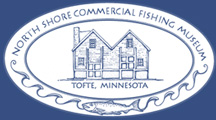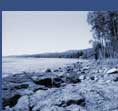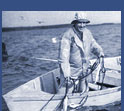 |
    |
|||
Events & ProgramsEvents Calendar More articles from the North Shore Commercial Fishing Museum Journal
|
North
Shore Commercial Fishing Museum Journal
NOR'WESTER BASHES LAKE SUPERIORBy Ted Tofte Fishing during the fall and winter months was tough, hard work. Picking herring hour after hour in ice cold water, with just one thin pair of wollen mittens, which were always soaking wet, could mean only one thing: discipllined, stubborn endurinace. But it also meant independence. It meant working for yourself. No unvarying ten hours a day, six days a week in some factory, though occasionally there could be a series of sixteen or seventeen hour days. There was drudgery and there were disappointments but there was the everlasting challenge of matching wits with nature and there were the excitements of the big runs of herring. One thing for certain, it was not a drab life. Fishing could also mean danger, especially the danger of being driven out to sea by the notoriously fierce winds that swept out of the northwest. Down through the years, the suddenness and violence of these raging gales struck fear into the heart of many a fisherman who was caught off guard for just a brief period, or who made a misjudgment about the wind's probable severity, for in its first stages it could be so deceiving. In these early days the herring nets were set not so very far out from shore, at most not over a mile, but these men were out these, often alone in relatively samll boats called skiffs, and until the 1920's, their only means of propulsion was a pair of oars. Furthermore, no matter what the weather, they were exposed to the wind and the cold without any cover or shelter of any kind, and a northwester spelled extremely cold temperatures, many days down to ten degrees below zero or colder. When strangers who saw them in the actual performance of their work, would ask in amazed disbelief, "How can you possible stand the cold?" they would invariably downplay their role with some modest reply as, "The water never gets colder than 32 degrees." This was true enough, but the wind was still just as cold as on land- often 10 degrees or 15 degrees below zero. Also they were our there completely on their own, for until 1928 there was no Coast Guard to come to their rescue in case of trouble. It was truly man alone against the sea. I will never forget one severely cold day when our party-line telephone sounded the long alarm ring. One of our neighbors, Andrew Olsen, son-in-law of Uncle Hanse Engleson, was caught out on the lake in a sudden northwester that had blown up. Our first thoughts were about Dad and Uncle John and Uncle Hans for they had been out there too! We dashed breathlessly to the fish house. There we found several people gathered. Dad and our two uncles had made it to shore and they were methodically preparing a skiff in which to try for a rescue: some extra wollen jackets, some dry, warm mittens, some coils of rope, and an extra pair of oars. There were younger men around, but this job was to be done by the older tested hands. Quiet prevailed among the onlookers as these men rowed forth close to shore where the wind took least hold. Dad and Uncle John sat side by side in the front seat, facing the back end of the boat for maximum pulling power. Each had one oar. Uncle Hans, the oldest of the three, was in the back seat, looking forward, pushing this oars, steering, directing, and checking. No sudden dash was this, for all possible energy must be saved for the homeward pull. We all looked towards Andrew. We could see him only occasionally through the cold vapor that rose fifteen or more feet above the lake, an indication of how cold it was. He had tied his boat to his nets, so he was thus prevented from blowing out. He was hunkered down in the boat to protect himself from the wind, but no one could last long in that severe cold. When the rescue trio reached a point directly in shore from Andrew, they began to move out slowly. At times they paused to test their own capacity to return. Then finally they moved firmly and directly to Andrew's boat. Through the fog we was Andrew move into the rear end of the rescue boat. Instead of the quick pull for shore that we expeced, these was an interminably long pause which we could not understand. Why not a dash for Shore? Then suddenly, as they finally began to move, ti became clear what they were doing. They had fastened Andrew's boat behing their own and they were bringing it in, too. They had carefully assessed the wind on the way our, and they had dtermined that they could safely manage to bring the boat in. No use to abandon a good skiff if it was unnecessary. Moreover, if the wind proved too strong, Andrew was prepared to cut his boat loose. Slowly and steadily they rowed to shore and home. Through it all, we waited in silence with just a few quiet words now and then. Even when they finally directed their boat up onto the skids to waiting hands, there was no boisterousness of any kind, just a brief comment here and there, and an air of relief, and thankfulness. In days to come, there were occasional references to this experience, but always they were joking, joshing remarks, like, "Next time, Andrew, I bet you won't forget to take along your thermos of hot coffee." Beneath this light-hearted teasing, in every mind, there was a quiet and ever deeper respect for the power and danger of old Lake Superior in the throes of a winter northwester. |
|||
 |
||||
|
Plan Your Visit | Events & Programs | Exhibits | Collections | Museum Store | Membership | About Us | Home © copyright 2003, North Shore Commercial Fishing Museum. http://www.commercialfishingmuseum.org web design by homepage design |
||||